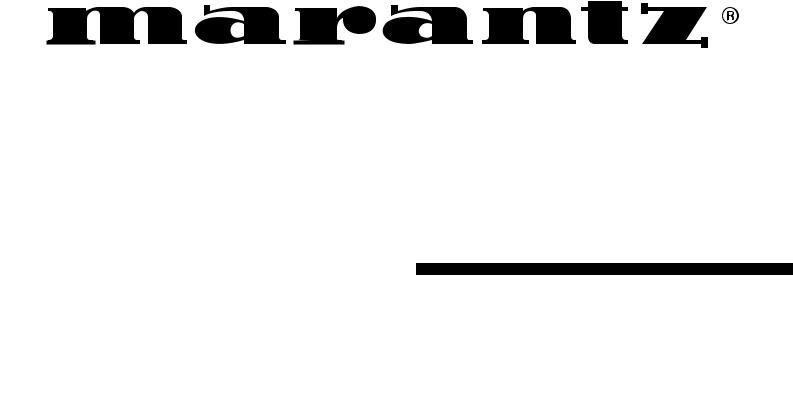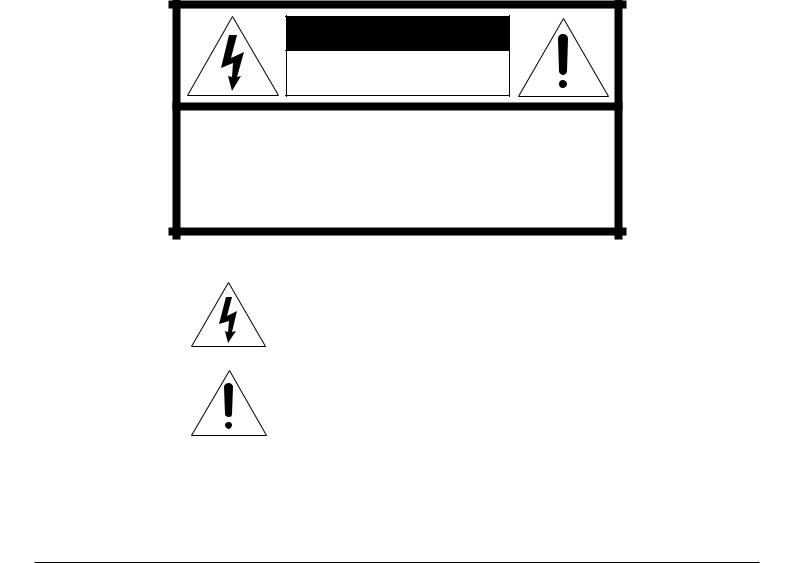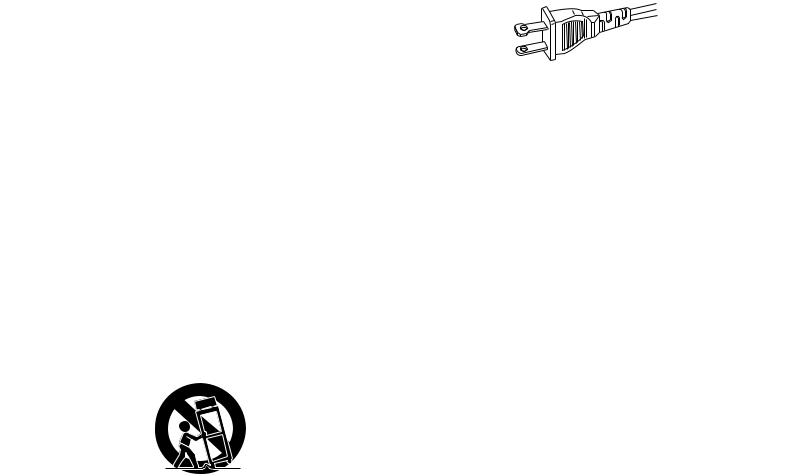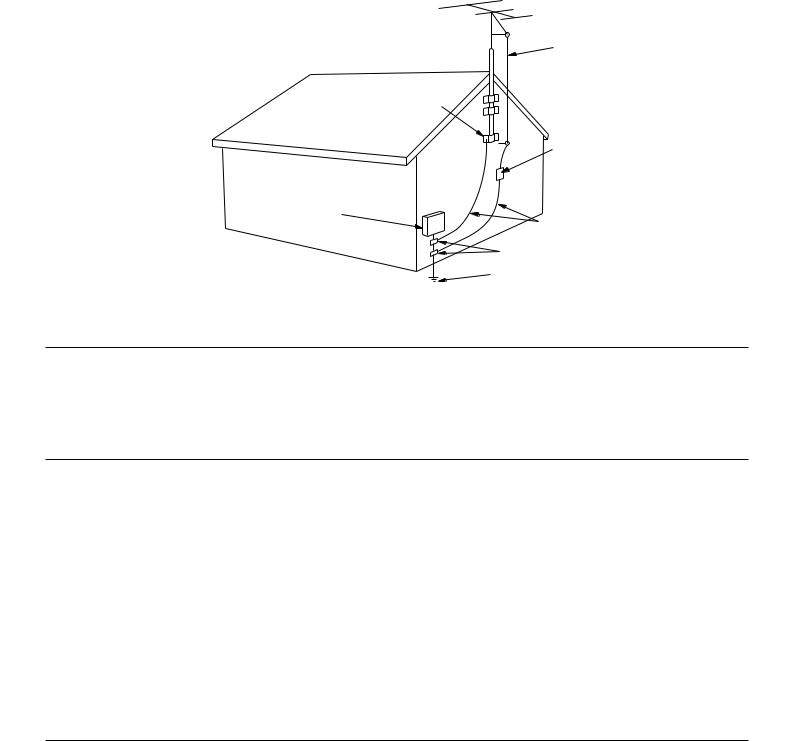Marantz PM7000 User Manual

English
Français
Model PM7000 User Guide
Integrated Amplifier
English
Français
1

English
aisçFran
|
CONTENTS |
Engligh ...................................................................................................................................... |
page 6 |
Français .................................................................................................................................. |
page 15 |
English
Français
2

English
aisçFran
CAUTION
RISK OF ELECTRIC SHOCK
DO NOT OPEN
CAUTION: TO REDUCE THE RISK OF ELECTRIC SHOCK,
DO NOT REMOVE COVER (OR BACK)
NO USER-SERVICEABLE PARTS INSIDE
REFER SERVICING TO QUALIFIED SERVICE PERSONNEL
The lightning flash with arrowhead symbol, within an equilateral triangle, is intended to alert the user to the presence of uninsulated "dangerous voltage" within the product's enclosure that may be of sufficient magnitude to constitute a risk of electric shock to persons.
The exclamation point within an equilateral triangle is intended to alert the user to the presence of important operating and maintenance (servicing) instructions in the literature accompanying the appliance.
WARNING
TO REDUCE THE RISK OF FIRE OR ELECTRIC SHOCK, DO NOT EXPOSE THIS APPLIANCE TO RAIN OR MOISTURE.
CAUTION: TO PREVENT ELECTRIC SHOCK, MATCH WIDE BLADE OF PLUG TO WIDE SLOT, FULLY INSERT.
ATTENTION: POUR ÉVITER LES CHOCS ÉLECTRIQUES, INTRODUIRE LA LAME LA PLUS LARGE DE LA FICHE DANS LA BORNE CORRESPONDANTE DE LA PRISE ET POUSSER JUSQU'AU FOND.
English
Français
3

English
aisçFran
SAFETY
INSTRUCTIONS
READ BEFORE OPERATING EQUIPMENT
This product was designed and manufactured to meet strict quality and safety standards. There are, however, some installation and operation precautions which you should be particularly aware of.
1.Read Instructions — All the safety and operating instructions should be read before the appliance is operated.
2.Retain Instructions — The safety and operating instructions should be retained for future reference.
3.Heed Warnings — All warnings on the appliance and in the operating instructions should be adhered to.
4.Follow Instructions — All operating and use instructions should be followed.
5.Water and Moisture — The appliance should not be used near water-for example, near a bathtub, wash-bowl, kitchen sink, laundry tub, in a wet basement, or near a swimming pool, etc.
6.Carts and Stands — The appliance should be used only with a cart or stand that is recommended by the manufacturer.
7.An appliance and cart combination should be moved with care. Quick stops, excessive force, and uneven surfaces may cause the appliance and cart combination to overturn.
8.Wall or Ceiling Mounting — The appliance should be mounted to a wall or ceiling only as recommended by the manufacturer.
9.Ventilation — The appliance should be situated so that its location or position does not interfere with its proper ventilation. For example, the appliance should not be situated on a bed, sofa, rug, or similar surface that may block the ventilation openings; or, placed in a built-in installation, such as a bookcase or cabinet that may impede the flow of air through the ventilation openings.
10.Heat — The appliance should be situated away from heat sources such as radiators, heat registers, stoves, or other appliances (including amplifiers) that produce heat.
11.Power Sources — The appliance should be connected to a power supply only of the type described in the operating instructions or as marked on the appliance.
12.Grounding or Polarization — Precautions should be taken so that the grounding or polarization means of an appliance is not defeated.
AC POLARIZED PLUG
13.Power-Cord Protection — Power-supply cords should be routed so that they are not likely to be walked on or pinched by items placed upon or against them, paying particular attention to cords at plugs, convenience receptacles, and the point where they exit from the appliance.
14.Cleaning — The appliance should be cleaned only as recommended by the manufacturer.
15.Power Lines — An outdoor antenna should be located away from power lines.
16.Outdoor Antenna Grounding — If an outside antenna is connected to the receiver, be sure the antenna system is grounded so as to provide some protection against voltage surges and built up static charges.
Section 810 of the National Electrical Code, ANSI/NFPA No. 70 — 1984, provides information with respect to proper grounding of the mast and supporting structure, grounding of the lead-in wire to an antenna discharge unit, size of grounding conductors, location of antenna-discharge unit, connection to grounding electrodes, and requirements for the grounding electrode. See Fig. 1.
17.Nonuse Periods — The power cord of the appliance should be unplugged from the outlet when left unused for a long period of time.
18.Object and Liquid Entry — Care should be taken so that objects do not fall and liquids are not spilled into the enclosure through openings.
19.Damage Requiring Service — The appliance should be serviced by qualified service personnel when:
A.The power-supply cord or the plug has been damaged; or
B.Objects have fallen, or liquid has spilled into the appliance; or
C.The appliance has been exposed to rain; or
D.The appliance does not appear to operate normally or exhibits a marked change in performance; or
E.The appliance has been dropped, or the enclosure damaged.
20.Servicing — The user should not attempt to service the appliance beyond that described in the operating instructions. All other servicing should be referred to qualified service personnel.
English
Français
4

English
aisçFran
FIGURE 1
EXAMPLE OF ANTENNA GROUNDING ACCORDING TO
NATIONAL ELECTRICAL CODE INSTRUCYIONS
CONTAINED IN ARTICLE 810 -"RADIO AND TELEVISION EQUIPMENT"
ANTENNA LEAD
IN WIRE
GROUND CLAMP
ANTENNA DISCHARGE UNIT (NEC SECTION 810-20)
ELECTRIC
SERVICE
EQUIPMENT GROUNDING CONDUCTORS (NEC SECTION 810-21)
GROUND CLAMPS
POWER SERVICE GROUNDING ELECTRODE SYSTEM
(NEC ART 250, PART H)
NEC - NATIONAL ELECTRICAL CODE
NOTE TO CATV SYSTEM INSTALLER:
This reminder is provided to call the CATV (Cable-TV) system installer's attention to Article 820-40 of the NEC, which provides guidelines for proper grounding and, in particular, specifies that the cable ground shall be connected to the grounding system of the building, as close to the point of cable entry as practical.
NOTE:
This equipment has been tested and found to comply with the limits for a Class B digital device, pursuant to Part 15 of the FCC Rules. These limits are designed to provide reasonable protection against harmful interference in a residential installation. This equipment generates, uses and can radiate radio frequency energy and, if not installed and used in accordance with the instructions, may cause harmful interference to radio communications. However, there is no guarantee that interference will not occur in a particular installation. If this equipment does cause harmful interference to radio or television reception, which can be determined by turning the equipment off and on, the user is encouraged to try to correct the interference by one or more of the following measures:
–Reorient or relocate the receiving antenna.
–Increase the separation between the equipment and receiver.
–Connect the equipment into an outlet on a circuit different from that to which the receiver is connected.
–Consult the dealer or an experienced radio/TV technician for help.
NOTE:Changes or modifications may cause this unit to fail to comply with Part 15 of the FCC Rules and may void the user's authority to operate the equipment.
This Class B digital apparatus meets all |
Cet appareil numérique de la Classe B |
requirements of the Canadian Interference- |
respecte toutes les exigences du Règlement |
Causing Equipment Regulations. |
sur le matérier brouilleur du Canada. |
English
Français
5

English
aisçFran
ABOUT THIS USER’S GUIDE
Figure numbers refer to the illustrations located at the back of this User’s Manual. Numbers assigned to parts and controllers match the callout numbers used inside the illustrations.
ALL UPPER-CASE BOLD type indicates the name of a connection or controller as it is actually marked on the amplifier.
PRECAUTIONS
Note the following important precautions whenever operating the amplifier.
SELECTING A LOCATION
Take a few moments to consider the following points before choosing a place for the amplifier.
—Make sure ventilation holes are not blocked or covered.
—Ensure that air can circulate freely around the amplifier.
—Locate the amplifier on a surface that is free of vibration.
—Choose a place where the amplifier will not be exposed to interference from an external source.
—Avoid excessive heat, cold, moisture, and dust.
—Keep the amplifier out of direct sunlight.
—Do not locate the amplifier where it will be exposed to electrostatic charge.
GENERAL SAFETY PRECAUTIONS
—Never place heavy objects on top of the amplifier.
—Should foreign matter or water get into the interior of the amplifier, immediately turn it off and contact your original dealer or Marantz service provider.
—Never pull on the mains lead when unplugging the amplifier. Grasp the plug itself.
—It is always a good idea to disconnect the amplifier from the mains supply whenever leaving it unattended for long periods or during thunderstorms.
CONNECTIONS
(Figure 1)
CONNECTING A TUNER
Connect the output jacks of your stereo tuner to the TUNER jacks of this amplifier.
CONNECTING A COMPACT DISC PLAYER
Connect the output jacks of your CD player to the CD jacks of this amplifier.
CONNECTING A TURNTABLE
Connect the L (Left) output cord of the turntable to the “L”PHONO jack of this amplifier, and the R (Right) output cord to the “R”PHONO jack. If the turntable has a ground wire, make sure you connect it to the GND terminal of this amplifier. The GND terminal does not need to be connected if the turntable does not have a ground wire.
CONNECTING A TAPE DECK
Connect the IN (recording input) jacks of the tape recorder to the TAPE OUT jack of this amplifier, and the OUT (playback output) jacks of the tape recorder to the TAPE IN jack.
CONNECTING A PROCESSOR
Connect the IN jacks of the processor to the PROCESSOR OUT jack of this amplifier, and the OUT jacks of the processor to the PROCESSOR IN jack. When not used, leave these jacks connected with the supplied connecting pins.
CONNECTING A SPEAKER SYSTEM
Your amplifier has two sets of SPEAKER SYSTEM terminals, which means you can connect either one or two speaker systems.
NOTE:
Turn the knobs on the speaker terminals by hand.(Do not use a tool to turn the knobs.)
•CONNECTING ONE SPEAKER SYSTEM
Note the following points when connecting a single speaker system.
—The impedance of each speaker should be minimum 8 ohms. Connecting a speaker with impedance less than 8 ohms can causes activation of the amplifier’s protection circuitry during play, making normal stereo playback impossible.
—Connect the right channel speaker to the amplifier’s R terminals, and the left channel speaker to the L terminals.
—The output terminals have positive (+: red) and negative (–: black) polarity. Each speaker must also have the same polarity (+/–). Be sure to match the polarity of the amplifier with that of the speakers (+ with +, – with –) when making connections.
•CONNECTING TWO SPEAKER SYSTEMS
Make sure that the impedance of each speaker is minimum 16 ohms. Connecting a speaker with impedance less than 16 ohms can causes activation of the amplifier’s protection circuitry during play, making normal stereo playback impossible.
English
Français
6
